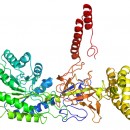Documentation of nnrank1.1 |
Nnrank1.1 is a machine learning software and a neural network software for ordinal regression and classification. It supports training, testing, and ensemble.
-----------------------------------------------------------------------------------------
Installation:
unzip nnrank.tar.gz on Linux.
(1) Four programs: nnrank, nnrank_predict, nnclass, nnclass_predict.
Ordinal regression:
nnrank: training and testing
nnrank_predict: prediction
Classification
nnclass: training and testing
nnclass_predict: prediction
(2) data: contains 20 pairs of training and test datasets generated from Abalone dataset.
(3) class.sh: a script to test nnclass.
(4) rank.sh: a script to test nnrank.
-----------------------------------------------------------------------------------------
Input data format:
InputDimension
ClassNum class1 class2 ...
DataPointNum
class input1 input2 ....
Class is represented by integer starting from 0.
For ordinal regression, classes are ordered by the value of intergers.
For an example, see: ./data/abalone_train_5.1 as follows.
10
5 0 1 2 3 4
1000
0 0.00000 0.00000 1.00000 0.24500 0.19000 0.06000 0.08600 0.04200 0.01400 0.02500
......
Explaination :
input dimension is 10.
number of classes is 5, represented by 0, 1, 2, 3, 4.
number of data points: 1000
the label of the first data point is: 0,
feature values of the first data point is:
0 0.00000 0.00000 1.00000 0.24500 0.19000 0.06000 0.08600 0.04200 0.01400 0.02500
---------------------------------------------------------------------------------------
Usage of programs:
(1) Ordinal regression training
nnrank options training_file
Options:
-t test file
-m file to save trained model
-h number of hidden units (default: 10)
-e number of epochs (default: 500)
-s random seed (default: 999)
-r learning rate (default: 0.01)
-b number of batch (default: total number of data points)
This parameter controls the learning mode. If it is set to the total number of data points (n), neural network update weights per example. Otherwise, it updates weights for every n / m examples.
m is the number of batch.
-a adaptive parameter to adjust learning rate (default: 50)
This parameter instructs neural network to halve learning rate if the training error continuously goes up for a specified number of epochs.
(2) Ordinal regression prediction
nnrank_predict options?? model_file?? test_file
Options:
-o output file (default: standard output)
-d decision threshold (default: 0.5)
This program computes accuracy on the test dataset.
It does not report detailed prediction results.
(3) Ordinal regression prediction using ensembles
nnrank_ens -d threshold model_definition_file test_dataset
threshold: default 0.5.
model_definition_file is used to specify the trained neural network models.
(for an example: rank_model.def)
line 1: num_of_models num_of_classes
line 2: path to a model file
line 3: path to a model file
....
Run rank_ensemble.sh to test it.
(4) classification training
nnclass options training file
Options:
-t test file
-m file to save trained model
-h number of hidden units (default: 10)
-e number of epochs (default: 500)
-s random seed (default: 999)
-r learning rate (default: 0.01)
-b number of batch (default: total number of data points)
-a adaptive parameter to adjust learning rate (default: 50)
(5) classification prediction
nnclass_predict options?? model_file?? test_file
Options:
-o output file (default: standard output)
-d decision threshold (default: 0.5)
(6) classification prediction using ensembles
nnclass_ens model_definition_file test_dataset
threshold: default 0.5.
model_definition_file is used to specify the trained neural network models.
(for an example: class_model.def)
line 1: num_of_models num_of_classes
line 2: path to a model file
line 3: path to a model file
....
Run class_ensemble.sh to test it.
--------------------------------------------------------------------------------------------
History:
NNRank 1.0: 10/2006
NNRank 1.1: 4/2007
I thank Yuping Shen help idenfity a bug in the code (AMBIBUITY due to division by 0).
---------------------------------------------------------------------------------------------
Reference:
J. Cheng and G. Pollastri. A Neural Network Approach to Ordinal Regression. International Joint Conference on Neural Networks (IJCNN), Hongkong, 2008.
Contact:
Dr. Jianlin Cheng
Department of Computer Science
University of Missouri
Email: chengji@missouri.ed
|

